The following information on disarming an armed opponent comes from Section 55 of Shooting by J. Henry FitzGerald. Shooting is also available to purchase in print.
Many surprise holds are used upon a prisoner or for protection by the civilian. A few of these that I have taught and used in police work I will illustrate. The day of promiscuous head breaking with clubs is passed except in certain cases where all other methods fail. It does not increase the popularity of a police department to hammer a prisoner into insensibility on a crowded street and at all costs he must get his man; therefore, the seemingly milder method which to the onlooker seems more humane is in reality more painful than the club.
A course in jiu-jitsu consists of twenty-five to thirty-five holds, but it is unnecessary for an officer or civilian to learn all these; three or four holds at his finger ends is better than the entire list because a surprise hold must be applied instantly and with pressure enough to enforce submission. A strong man may be subdued if hold is applied before he has time to set his muscles against it even by a much weaker antagonist.
The Lip Hold is very effective on wild women and some little men and consists of catching the loose flesh of lower lip between first finger and thumb, pulling outward and twisting if the straight pull should fail. Usually this hold is sufficient to lead a prisoner wherever necessary. It is usually as severe as before-mentioned lady will care to endure and may be the means of cutting short a needless conversation.
A very fine hold for the civilian to use in case of a hold-up, where arm of hold-up gentleman is concealed in the outside coat pocket and pointed through the cloth, is, as the arms go up at command, with right hand grasp the shoulder of assailant turning him toward the right. Grasp his left wrist with your left hand, swinging his left hand behind his back and up between the shoulder blades—the Hammer Lock. In the meantime slide right hand from the shoulder to the wrist and hand concealed in the pocket before it can be withdrawn, being careful at all times to keep his body between yourself and the suspected pocket. With this hold he can easily be held until help arrives. If no help is in sight place right leg and hip in front and throw him on his face, being careful not to loosen the hammer lock; as he goes down in this position the weapon in pocket may be safely reached. Enough pressure may be applied to break the arm in the hammer lock if necessary.
The Hand Hold, palm up, is very effective and consists of grasping the fingers of opponent’s left or right hand and raising them above his head, palm up, exerting a downward pressure on the ends of his fingers. The more pressure applied the less desire he will have to strike you with the other hand. Any pressure or any hold applied against the natural direction in which joints and muscles are supposed to move is effective if properly applied.
The Coat Arm Lock is applied by throwing an open coat downward from shoulders and halfway between shoulders and elbow; both arms are then held at the side.
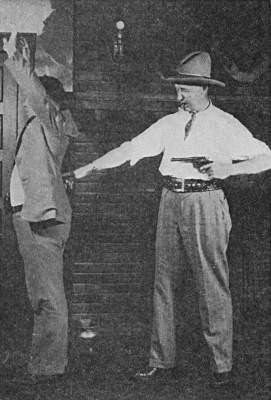
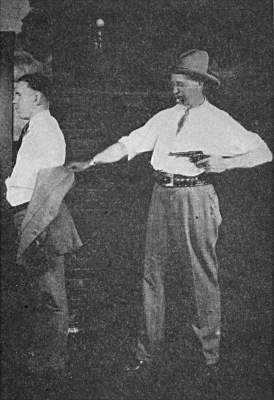
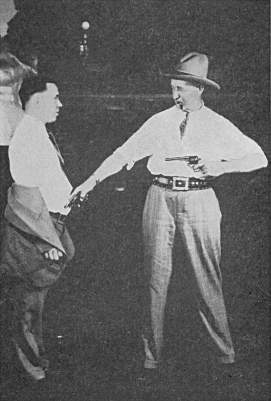
Many still believe that the under hold or arms around body under the arms is a good hold and it would be if the opponent’s arms were included with the body; otherwise three very effective ways to break this hold are left open: the chin is grasped with one hand, then forced upward, or chin is grasped with one hand, back of head with the other, then head is twisted until hold under arms is broken. A quick snap will break the neck.
The Nose Hold will also break the underarm hold. Place heel of hand under the nose and force quickly upward; this is an effective way to have the face lifted. If the hold is around arms and body, bring hands together at front and force them upward between opponent’s body and your own until the hold is broken; then apply a hold of your own.
The Adam’s Apple Blow is striking the opponent with side of hand or fist on the Adam’s apple. A sharp blow will bring results, usually dropping the person so struck.
The Stomach Blow is very effective. The bigger they are the harder they fall. This consists of a short, sharp blow at about the third button on the vest; a six-inch blow will be effective.
The Finger Hold consists of bending any of the fingers inward toward the palm, thumb on end of finger, and first finger under second joint.
A successful way to break the Throat Hold is, instead of trying to pull the entire hand away, take one finger at a time, bending it over backward until it breaks.
The Belt Hold consists of grasping opponent’s belt at center of back and pushing him forward; very effective in forcing a prisoner along as he cannot turn around.
The Arm Grip, palm up, consists of grasping opponent’s hand, palm up, and then with other arm under elbow grasp opponent’s coat on the opposite side from where you are standing. Then force opponent’s hand downward, holding your own arm under his elbow.
A very effective way to throw an opponent over the head is to cross the hands, grasping a lapel of the opponent’s coat in each hand; turn quarter round and pull forward, crouch or drop to one knee. Scarcely any strength is required to perform this feat and, if necessary, the fall may be as severe as required.
The Ear Pressure Hold consists of forcing thumb between the two bones just under the ear. This may be applied to both sides at the same time, if necessary, grasping collar with three fingers to hold the prisoner’s head and body in position and the pressure may then be applied.
The Hair Hold consists of grasping the hair at back of head and lifting upward, if opponent refuses to rise. The Cheek Hold consists of forcing the thumb against side of face halfway between eye and mouth; very effective if opponent refuses to go through a door and hands are braced on door jambs to prevent being pushed through. Still I am inclined to favor grasping both legs and pulling his feet away from door; then he will get a fall he will never forget.
The Hip Lock is a hold every one knows and consists of throwing opponent over the hip.
The ladies can be taught one very effective hold, or protection measure, consisting of forcing one or two fingers into the opponent’s eyes when grasped by him.
Now comes the dangerous part of defense work,—foiling the gunman. If held up and opponent’s revolver is placed muzzle against stomach, with command of “Hands up,” put them up at once. If opponent is holding revolver in right hand, drop right hand quickly on cylinder of revolver, at the same time holding body against muzzle. Turn to left to force barrel out of line with body. The hand on cylinder will prevent trigger being pulled if a revolver is not cocked; if it is an automatic, turning the body will prevent being struck by the bullet and if slide is held the empty shell will remain in the chamber of automatic. Then force muzzle of either quickly upward to vertical position and push the revolver or pistol in this position sharply downward. This will break opponent’s trigger finger at second joint. There are many ways to disarm a man who places a revolver against stomach and they are all good, but most of them require two hands. This requires one hand and is very effective. I have used it for years and have yet to find a man who could snap the arm, with muzzle still toward any part of the body, if he waited until he saw me move, even after he knew what I was going to do. I have been asked many times if it were not possible to put a revolver against a man’s stomach in such a manner that he could not take it away. My answer is to push the revolver in about three inches and he will not try to disarm you.
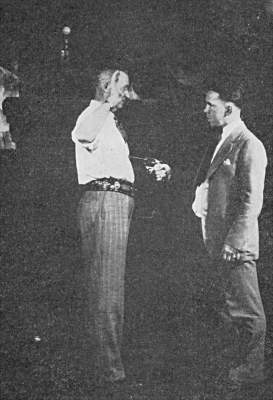
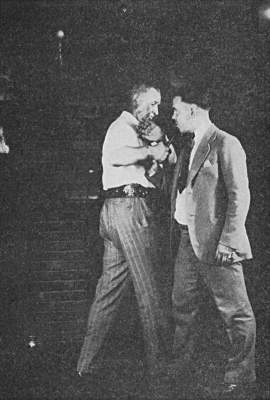
A man with experience would not get close enough to be disarmed in this way. He would stand about six feet away and, when hands were up, order his man to turn and face the wall; then, with his own revolver well back at the side, search the prisoner, first trying him out by placing finger in his back. He might turn around and try to take what he believed to be the revolver away from you while said revolver is safe at side in the other hand. In nearly every case any one who came up from behind would place the revolver against the back instead of the finger. The difference can be told by pressing the back slightly against the muzzle or finger. In case it is the revolver, swing the body sharply around, knocking the muzzle out of line with the elbow and grasping cylinder with right hand as you turn; then proceed to break finger as before. An effective addition to this hands-up, revolver-in-stomach get-away, is to grasp the hat brim with left hand, while hands are up, and slap the opponent across the face as hands are dropped.
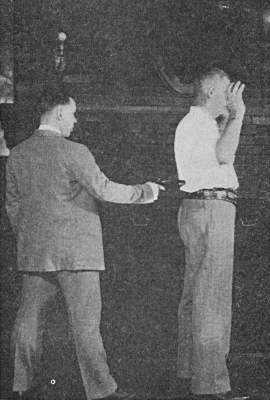
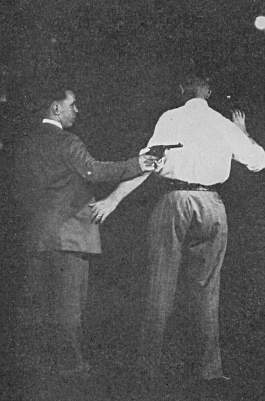
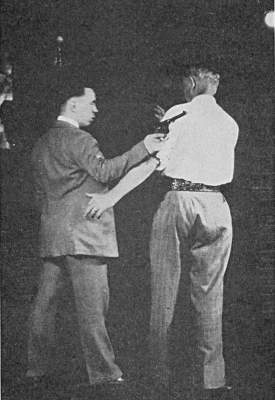
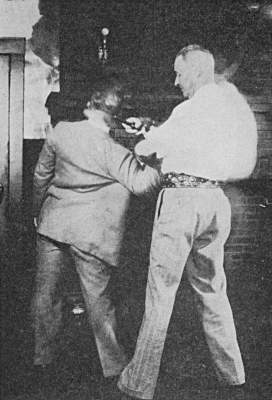
In all holds and all tricks watch the opponent’s feet as well as his hands. Some men are as clever with their feet as they are with their hands and may get in a decisive blow with either foot or knee. Many men have found this out when too late to avoid losing a prisoner.
For an officer to search thoroughly constitutes nearly disrobing the prisoner. I have been searched by officers who even missed two .45 revolvers and allowed me, because they did not find them, to keep gas pencils, small automatics, pencil pistols, knife in shoes, knife at back of neck, revolver in hose and many other hide-outs after searching me to their satisfaction.
In leading a man to the police station extreme care must be taken, as your prisoner may know all the tricks of eluding his captor and, if so, he is dangerous at all parts of the journey. I favor the belt hold with revolver in the hand, or where it can be reached instantly.
But a man must be his own judge as to the amount of force to use and what precautions to take in getting his man, but never take a chance.
